Lou Assist for Proactive Customer Service: Features, Pricing, and Review
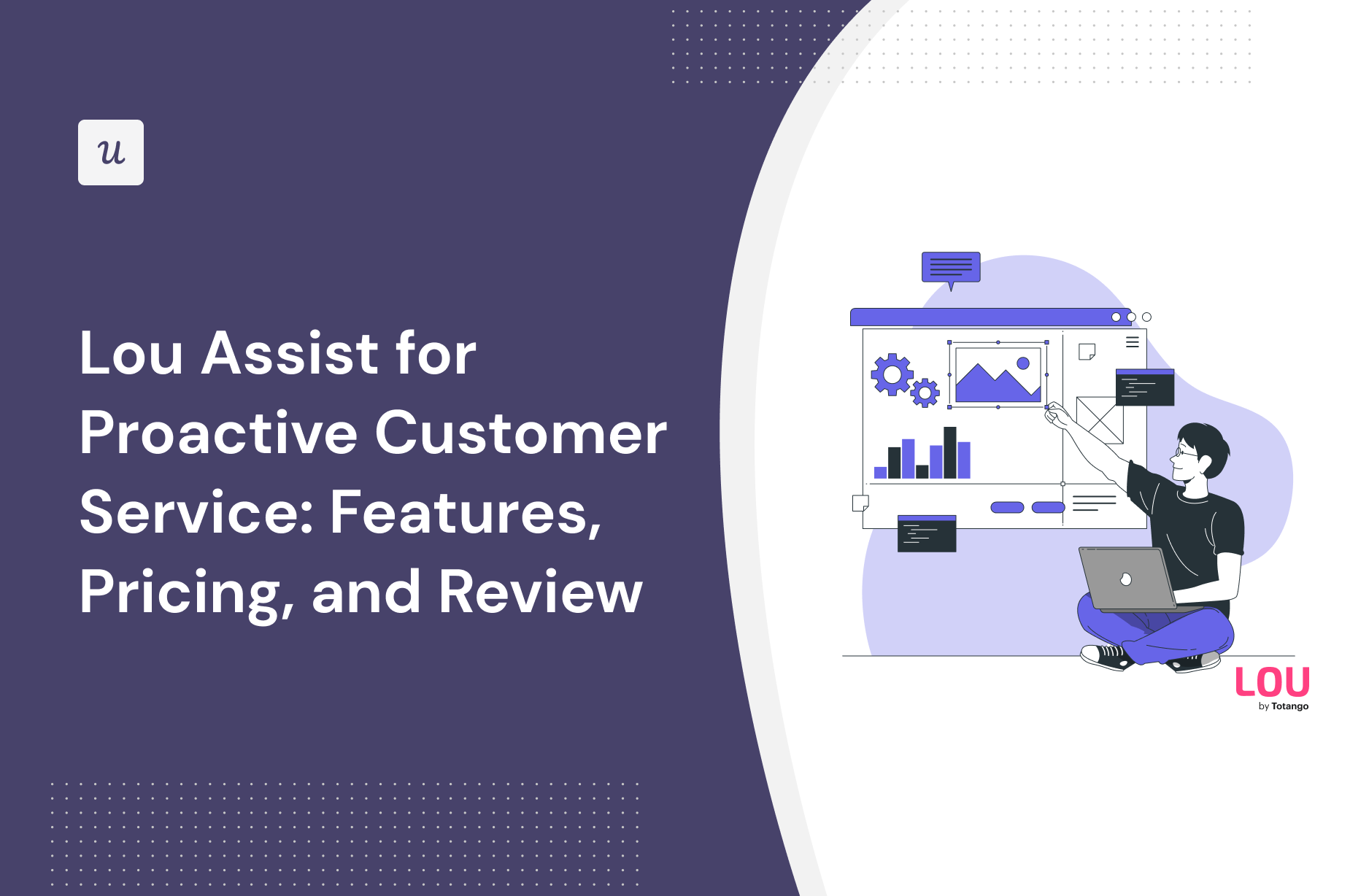
Looking for an effective proactive customer service tool and wondering if Lou Assist is the best option for your SaaS company?
With numerous Lou Assist alternatives, it can be challenging to make a final decision.
In this article, we’ll delve into precisely that – helping you determine whether Lou Assist is the ideal choice for your proactive customer service needs. We’ll explore its features, pricing, and offer a comprehensive review to aid in your decision-making process.
Let’s get started!
TL;DR
- Lou Assist is a good choice for proactive customer service and it comes with features such as tooltips, modals, in-app resource center, and interactive walkthroughs.
- Product Analytics: Lou Assist doesn’t have any product usage analytics capabilities. This means that its dashboards can only show you engagement metrics for content and experiences you’ve built within the Lou Assist platform rather than actual product analytics.
- International Users: Those with an international user base will be better served by other adoption platforms on the market. Lou Assist lacks any localization capabilities which makes creating in-app experiences for different languages a time-consuming hassle.
- Mobile Onboarding: Because Lou Assist is designed to be used on web apps rather than mobile apps, it has no compatibility with products developed for mobile platforms. If you’re developing a mobile app then consider alternatives like Appcues or Pendo.
- If you’re looking for a better option for proactive customer service, Userpilot exceeds both functionality and value for money compared to Lou Assist.
- Ready to see Userpilot in action? Schedule a demo today to explore its powerful proactive customer service capabilities firsthand.
![]()
Looking for a Better Alternative for Proactive Customer Service? Try Userpilot

What is Lou Assist?
Lou Assist is a product adoption tool built by the customer success platform Totango. It lets product teams add in-app guidance in the form of modals, tooltips, hotspots, banners, and highlights that can be built without writing any code.
Additionally, Lou Assist helps product teams collect feedback from their users by adding surveys within in-app experiences or creating NPS surveys to measure loyalty/advocacy.
Those who upgrade to the paid version of Lou Assist can also utilize its integrations with 14 third-party tools.
Must have features of proactive customer service tools
When choosing a customer service tool, focus on features that predict needs, enhance user experience, and simplify operations. Here are some features that you should consider:
- In-app guidance: A tool with contextual onboarding tooltips and other UI patterns can ease user frustration when understanding basic product features instead of navigating a busy support center.
- Targeted in-app help: Look for the tools that let you segment users by their jobs to be done, goals, and problems. This will enable you to provide users with relevant in-app help.
- Self-service options: Providing customers with the ability to solve their problems through chatbots, knowledge bases, and FAQ sections can be proactive and efficient.
- Real-time monitoring: Tools that monitor real-time product usage patterns can help you identify potential issues earlier to offer proactive support immediately.
- Feedback collection: Gathering feedback via various in-app surveys or feedback forms can reveal areas for improvement.
- Funnel analysis: Using funnel analysis, you can easily spot where customers are facing problems. With this information, you can provide proactive support in those areas and reduce churn.
Lou Assist features for proactive customer service
In-app support is incredibly important for keeping customers satisfied while minimizing the load on your CS representatives. Lou Assist does let you add tooltips or build tours for in-app support but it doesn’t let you create resource centers or integrate with popular support tools.
Here’s how you can use Lou Assist to reduce the support load on your team:
- Tooltips: Lou Assist lets you add tooltips to your products that explain what each feature is and how to use them. You can also use tooltips to proactively address frequently asked questions regarding specific features. You’ll even be able to adjust its positioning relative to the element.
- Tours: These multi-step tours can be used to welcome users, teach them how to use the product, and congratulate them at the end of the flow (if you insert a celebration step).
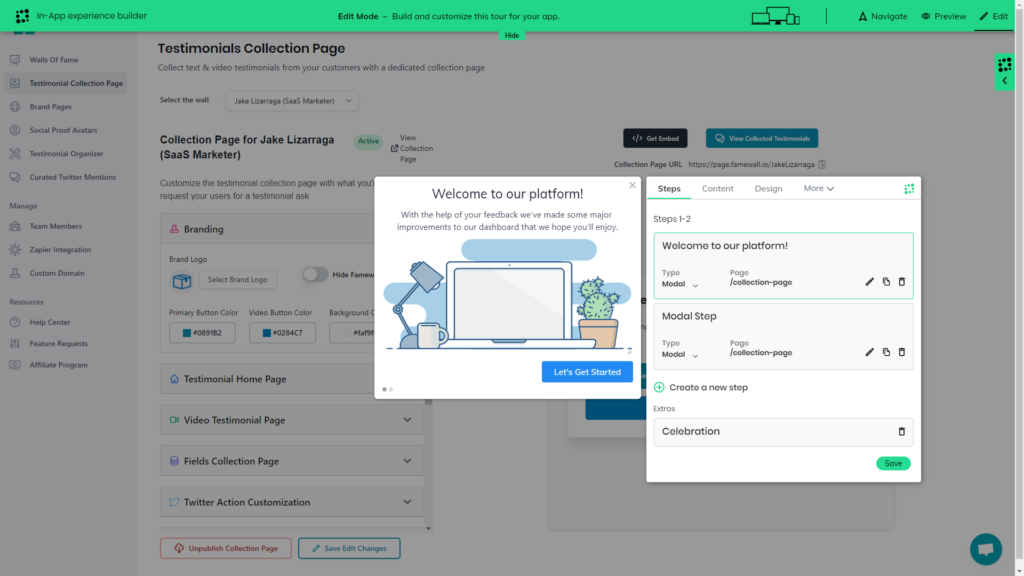
- Limitations: Lou Assist lacks key support features like an in-app resource center or content localization capabilities. It also lacks any integrations with support tools like Intercom, Zendesk, or Freshdesk (and integrations aren’t even available for users on the free plan anyway).
Lou Assist’s tooltips
Tooltips are helpful both when used as part of a larger flow or implemented as a standalone source of contextual information on a particular feature. Lou Assist lets you build no-code tooltips, adjust the positioning to match your UI, and target specific users or segments.
Here’s how you can use Lou Assist to create tooltips:
- Builder: The in-app experience builder lets you attach tooltips to elements or buttons within your product interface. You’ll be able to add avatars, links, images, videos, and custom code to your snippets to make them as engaging as possible for users.

- Positioning: Lou Assist’s positioning settings let you choose where you’d like tooltips to appear relative to the element they’re attached to. You can also select what will happen when a user clicks the element — such as the tooltip closing, the click registering, both, or neither.
- Targeting: The “Deliver” tab of the in-app experience builder helps you target specific segments, trigger tooltips when users land on a particular page, or launch them when an element is clicked on/hovered over. You can also adjust launch frequency and priority here.
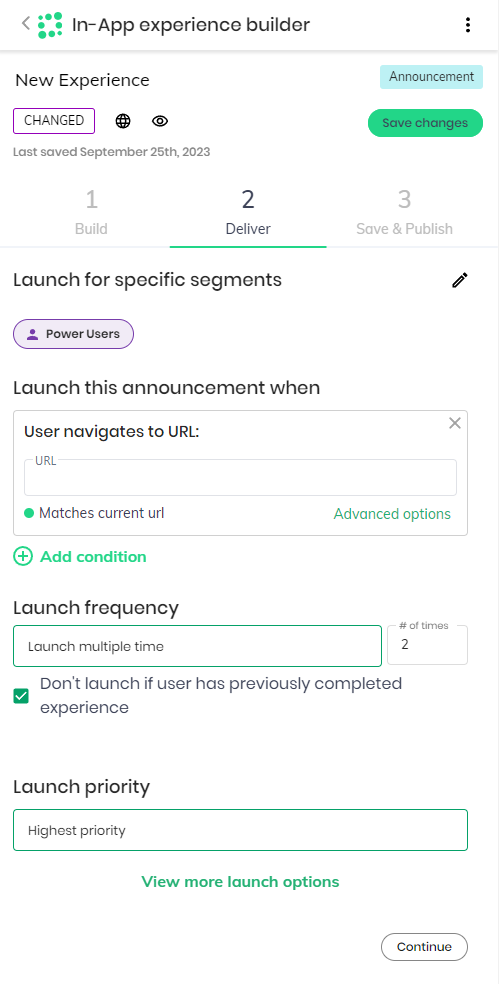
Lou Assist’s modals
Modal design is a careful balancing act since it’s the most intrusive UI pattern you can use. Lou Assist lets you use modals in product tours and announcements but significantly limits the number you can publish if you’re on the Free plan.
Here’s how you can use Lou Assist for building modals:
- Tours: When creating product tours with Lou Assist’s in-app experience builder, it has a welcome screen modal as the first step by default. You can insert additional modals into your product tours or edit the welcome template that Lou Assist starts you off with.

- Announcements: Lou Assist also lets you use modals to make in-app announcements. The builder lets you insert links, images, videos, and custom code into your modals. This makes them versatile enough for everything from new feature announcements to tutorial microvideos.
- Limitations: Users on the freemium version of Lou Assist will find that they are severely limited in the number of modals they can publish. The platform limits publishing to one tour and two announcements unless you upgrade to the Startup plan which costs $79/month billed annually.
Lou Assist’s in-app resource center
Lou Assist doesn’t have a resource center builder or any native features that would help you build one. The platform doesn’t have third-party integrations that could help you create a new resource center or import an existing knowledge base either.
If this is a primary use case for you, then you should consider tools like Userpilot that have built-in resource center features.
Lou Assist’s interactive walkthroughs
Interactive walkthroughs are better than linear product tours because they help users learn by doing instead of bombarding them with information. Lou Assist’s tooltips, hotspots, and other UI patterns make your interactive walkthroughs feel like a cohesive part of the product experience.
Here’s how you can use Lou Assist to build interactive walkthroughs that improve onboarding:
- Tooltips: Lou Assist tooltips can include agent avatars, images/videos, links, and custom code that help users learn more about a particular feature. Upon attaching a tooltip to an element, you’ll also be able to adjust its positioning and design to align it with your existing product UI.
- Hotspots: Self-explanatory features that don’t need tooltips could still benefit from a hotspot that attracts user attention. Lou Assist lets you set the position for your hotspot using the cursor or change the color of the dot using the color picker found in the positioning settings tab.

- UI Patterns: If tooltips and hotspots aren’t the right fit for your interactive tours then you can choose other UI patterns in Lou Assist’s experience builder. These include modals that appear on a user’s screen or highlights that can add flashing colors to an element to draw attention to it.

What are the pros and cons of Lou Assist?
Lou Assist’s pros
There are plenty of benefits to using Lou Assist, but the most notable are its unlimited capacity freemium plan, diverse array of UI patterns, and advanced targeting settings:
- Unlimited MAUs: The free version of Lou Assist doesn’t cap the number of monthly active users (MAUs) you can have on your platform. This stands in contrast to competitors like Pendo, which force customers to upgrade to a paid plan once they hit the 500 MAUs limit.
- UI Patterns: There’s a wide variety of UI patterns to choose from when building in-app experiences with Lou Assist. You can add modals, tooltips, hotspots, banners, and highlights, then adjust their design or positioning as needed.
- Targeting Settings: Lou Assist can target based on which segment a user is in, what page they’re on, and whether or not they’ve already completed the experience before. You can also adjust launch priority and frequency settings to dictate which experiences should appear or how often.
Lou Assist’s cons
Of course, Lou Assist has its fair share of drawbacks as well — and some of these cons even hinder or negate the benefits the platform has to offer:
- Analytics Dashboards: While Lou Assist does have analytics dashboards that can show you how in-app experiences, checklists, or surveys are performing, it only measures the performance of content created within the platform. There are no product usage analytics dashboards.
- Freemium Limitations: Despite the uncapped MAUs, the free version of Lou Assist has quite a few limitations. You’ll only be able to publish one tour, checklist, and survey at a time. You’ll also be limited to two announcements and won’t be able to create custom themes.
- Segment Caps: Lou Assist’s advanced targeting is hindered by the segmentation limits imposed by its pricing structure. Users on the free version can only create one custom segment, while those on the entry-level Startup plan can only create three.
Note: You can create unlimited segments if you subscribe to the Growth plan or higher but that tier starts at $239/month.
What do users say about Lou Assist?
Lou Assist users praised the flexibility that its various UI patterns provide, as well as the customizability that each in-app experience offers:
“It allows you to create different types of onboarding experiences for any kind of SaaS product, it feels well-categorized and provides a nice degree of customization.”
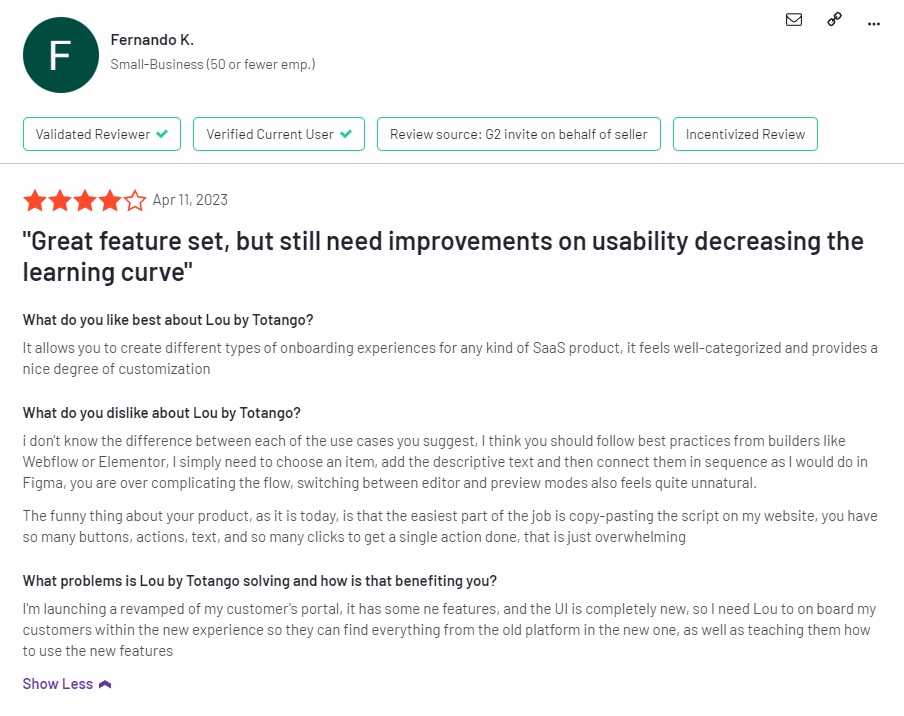 Some customers were disappointed by the lack of personalization and localization offered on Lou Assist, along with the inconsistent product experience caused by numerous bugs:
Some customers were disappointed by the lack of personalization and localization offered on Lou Assist, along with the inconsistent product experience caused by numerous bugs:
“Personalization is not deep enough, I encounter many many many bugs when editing modals. Sometimes it works, sometimes it doesn’t and it is very frustrating. Language is not supported so I have to make different modals for all my international users.”

Lou Assist’s pricing
Lou Assist has a free version that supports unlimited MAUs as well as three paid plans that can accommodate 2,500 to 10,000+ MAUs. The paid subscriptions range from $79/month on the entry-level Startup plan (with the annual discount) to $239/month for the Growth plan.
Here’s a closer look at each Lou Assist plan:
- Free: The Free plan doesn’t limit the number of monthly active users but does cap the number of tours, checklists, surveys, and announcements you publish. You won’t be able to use third-party integrations or create custom themes either.
- Startup: Starting at $79/month, it offers three team sets and can accommodate up to 2,500 MAUs. You’ll be able to publish unlimited tours/announcements but only one checklist and three surveys at a time.
- Growth: The Growth plan starts at $239/month (or $199/month if you pay annually) and increases your subscription’s capacity to 10,000 MAUs. You’ll also get 10 team sets and be able to publish an unlimited number of tours, checklists, surveys, and announcements.
- Enterprise: Lou Assist’s Enterprise tier operates on a quote-based pricing system but offers flexible MAU limits and unlimited team seats. You’ll also get a custom service-level agreement (SLA). Enterprise subscriptions have no monthly payment option, so you’ll need to pay annually.
3 Reasons why you might need a Lou Assist alternative
Lou Assist is an attractive product adoption platform with versatile in-app experiences and a freemium option to boot, yet its limitations in certain use cases may prompt you to look elsewhere:
- Product Analytics: Lou Assist doesn’t have any product usage analytics capabilities. This means that its dashboards can only show you engagement metrics for content and experiences you’ve built within the Lou Assist platform rather than actual product analytics.
- International Users: Those with an international user base will be better served by other adoption platforms on the market. Lou Assist lacks any localization capabilities which makes creating in-app experiences for different languages a time-consuming hassle.
- Mobile Onboarding: Because Lou Assist is designed to be used on web apps rather than mobile apps, it has no compatibility with products developed for mobile platforms. If you’re developing a mobile app then consider alternatives like Appcues or Pendo.
Note: Lou Assist is able to adjust screen sizes when your web app is viewed on mobile devices.
Userpilot – A better alternative for proactive customer service
 In-app support can increase customer satisfaction and retention rates. Userpilot has native in-app support features like resource centers and native tooltips as well as third-party integrations with popular support tools like Intercom to help you cover all your bases.
In-app support can increase customer satisfaction and retention rates. Userpilot has native in-app support features like resource centers and native tooltips as well as third-party integrations with popular support tools like Intercom to help you cover all your bases.
Here’s an overview of Userpilot’s in-app support capabilities:
- Resource center: Userpilot in-app resource centers let you add flows, checklists, external links, tutorial videos, external knowledge bases, and chatbots. You’ll also be able to view resource center analytics so you can check its performance.
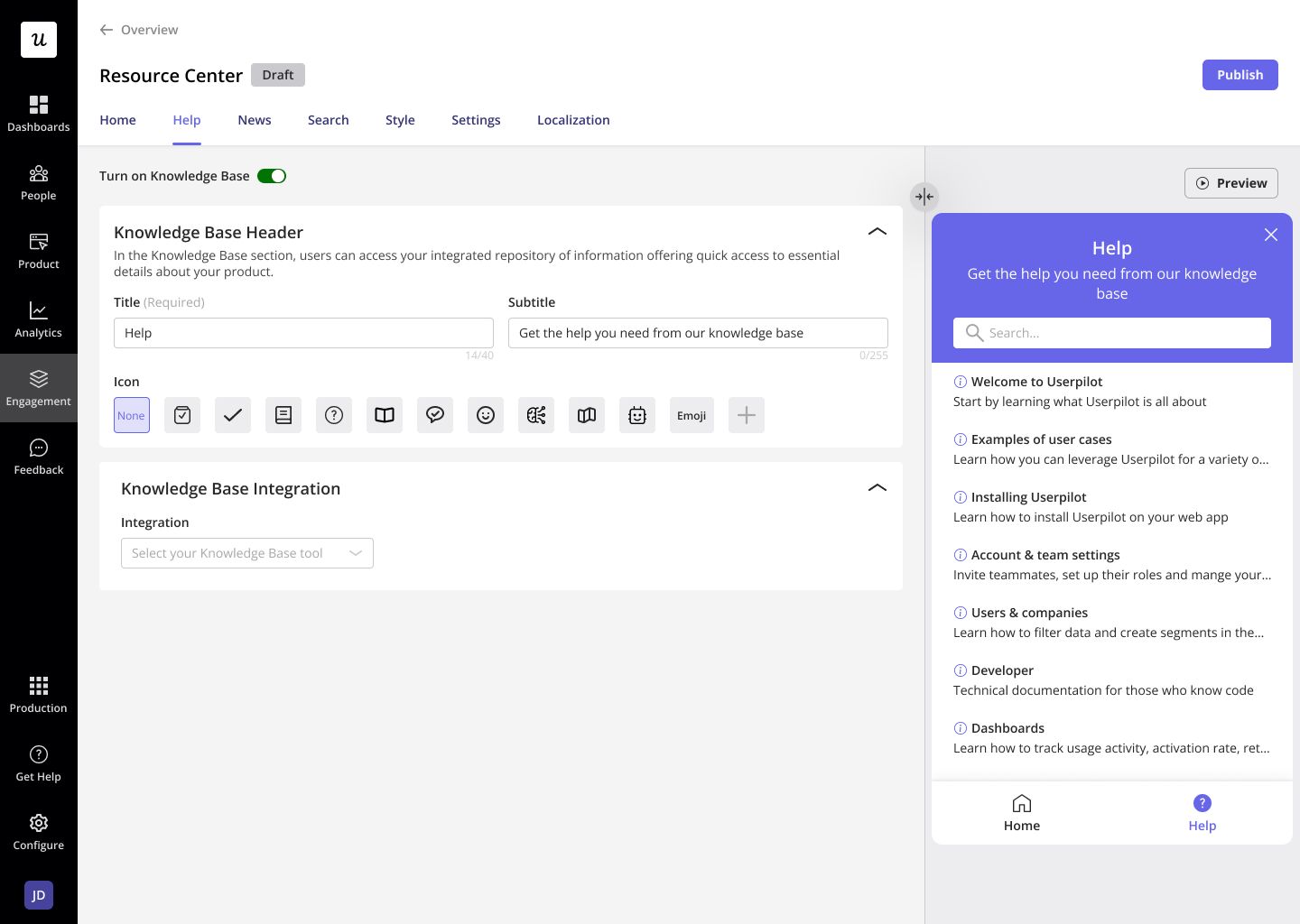
- Native tooltips: In-app support must be proactive — which is why you should insert tooltips that guide users before they even think to open the resource center. Userpilot lets you add native tooltips that appear whenever users hover over an element or click on the info badge.
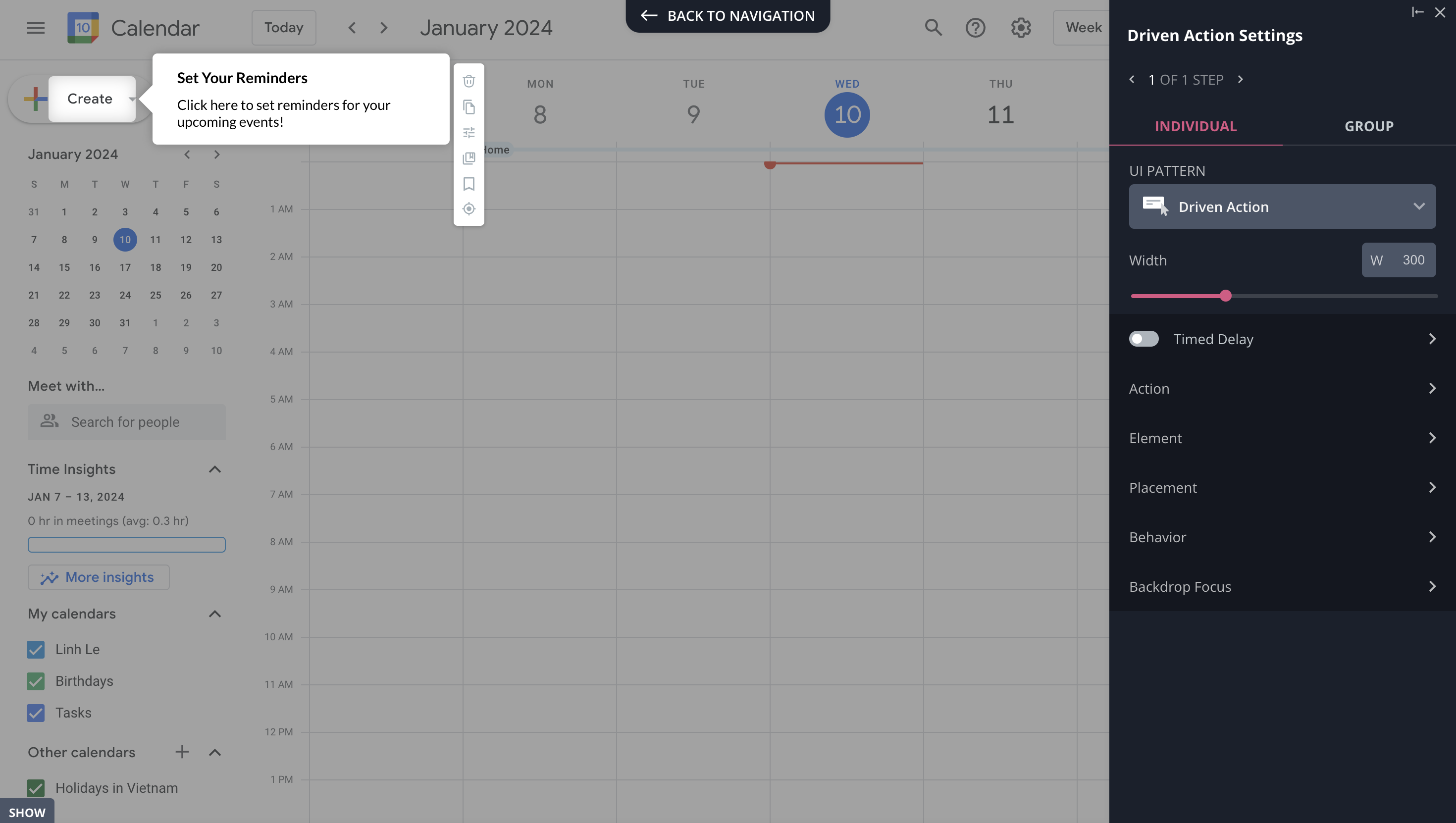
This a native tooltip example built with Userpilot, not an actual tooltip from Calendar by Google.
- Contextual flows: Userpilot’s trigger settings let you create contextual flows that automatically appear when a user reaches a certain page or performs a specific action. This can be used to offer in-app guidance and support whenever users try out a feature for the first time.

- Intercom integration: While Intercom is famous for its live chat embeds, you can do more than that by integrating it with Userpilot. You’ll see which events a user has done within Userpilot and whether or not they’ve completed onboarding to personalize support accordingly.

Userpilot’s tooltips
Tooltips are the most straightforward way to offer contextual information to users without interrupting their workflows. Userpilot lets you create tooltips as part of your in-app flows, attach standalone tooltips to individual features, and leverage the power of AI to streamline the process.
Here are the ways you can use Userpilot to create tooltips:
- Tooltip flows: Tooltips are one of the UI elements you can utilize when creating in-app flows. You’ll be able to edit the size, placement, and behavior of your tooltip as needed. You could also toggle the option to continue or dismiss the flow if a tooltip’s element can’t be located.

- Native tooltips: Userpilot spotlights let you create native tooltips that expand when users click on an element or hover over a feature. Since these tooltips are attached to the features rather than specific pages, they’ll show up anywhere that the element is present.
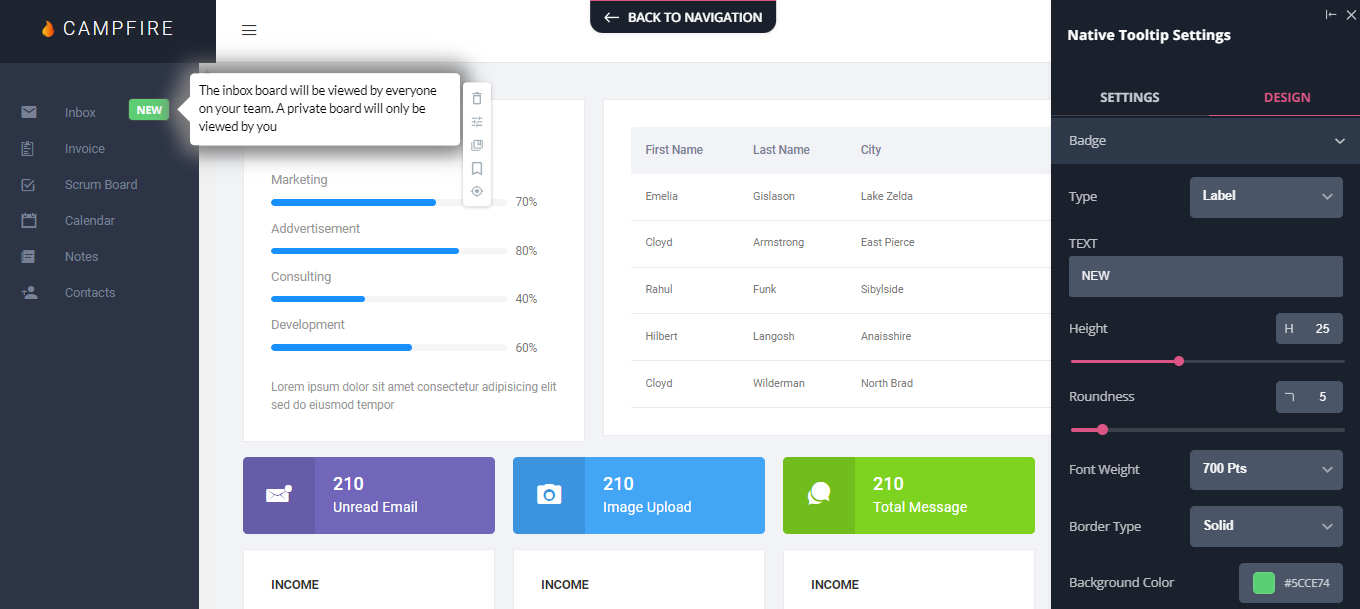
- AI assistance: Userpilot’s AI-powered capabilities help you create better tooltips in less time. You could use the writing assistant to create, shorten, or extend the content of tooltips and leverage automated localization to translate your flow’s tooltips to any of the 32 languages available.
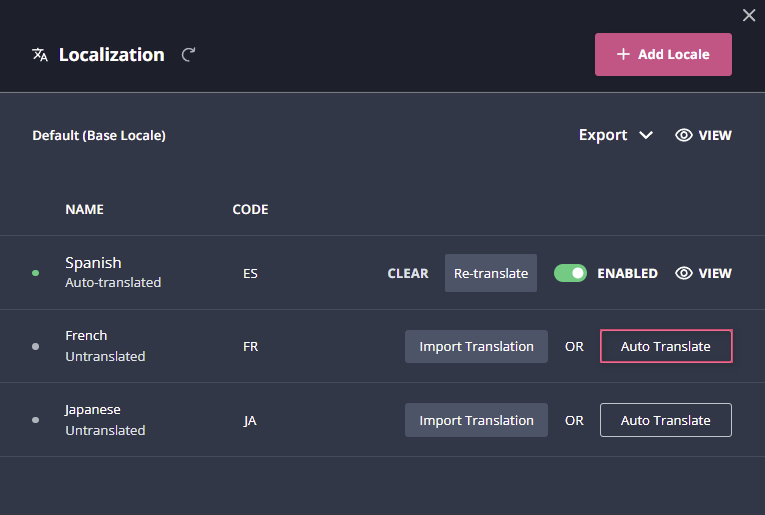
Userpilot’s modals
Modal UX design is a difficult task even for experienced designers, as you want to capture the user’s full attention without annoying them.
Userpilot’s modals can be made using templates, have advanced blocks added to them, and be translated into 32 different languages through AI. Here’s an overview of Userpilot’s modal design capabilities:
- Templates: There are six different modal templates to choose from but you can also create a new design from scratch. After making changes or building your own design, you can click on the bookmark icon to save this template for future use and add it to the template gallery.
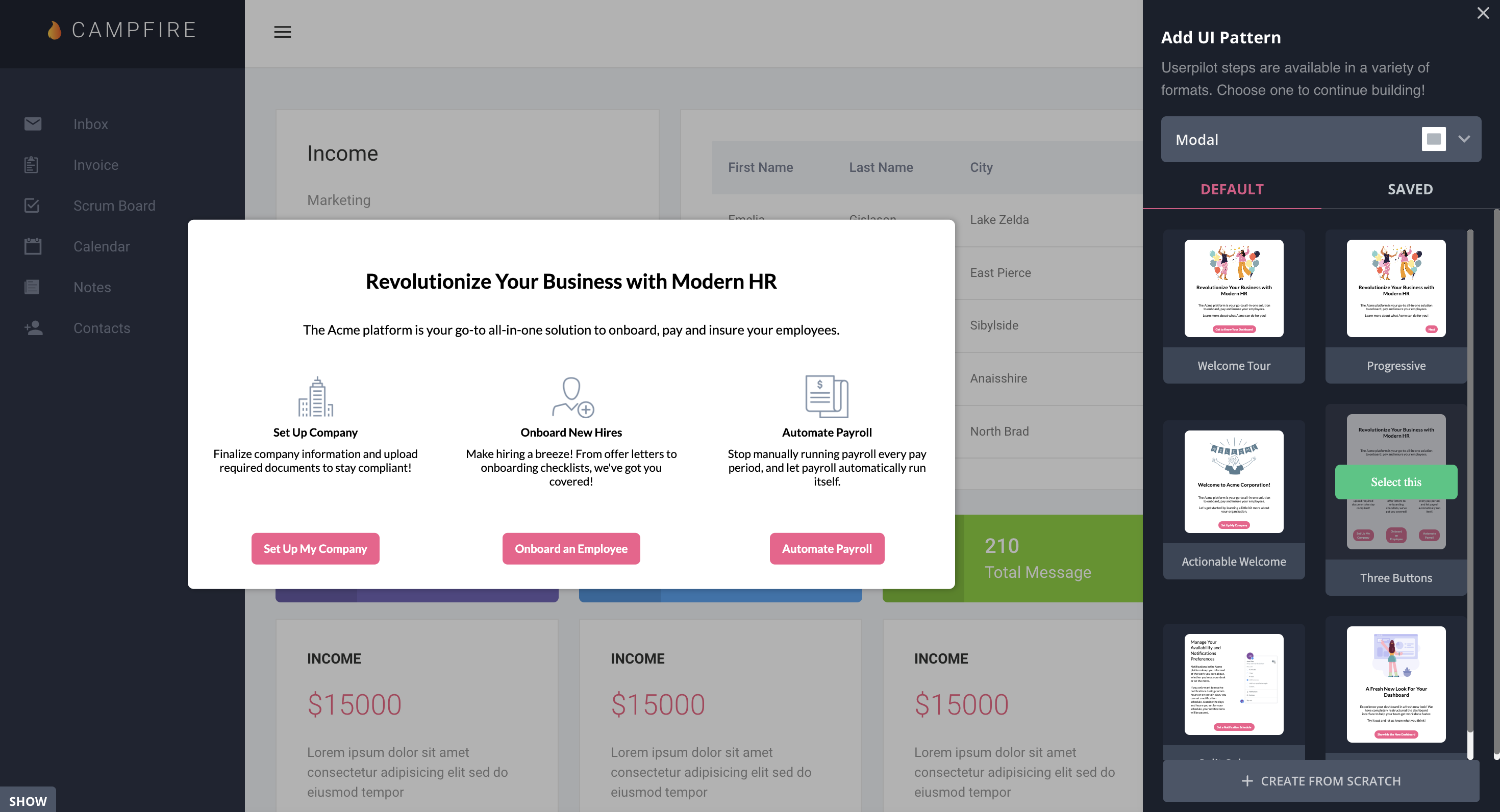
- Blocks: Userpilot lets you add blocks that contain buttons, text, emojis, images, videos, input forms, or custom JavaScript functions to make your modals as engaging as possible. You’ll also be able to edit or delete any existing blocks from the template you’ve chosen.
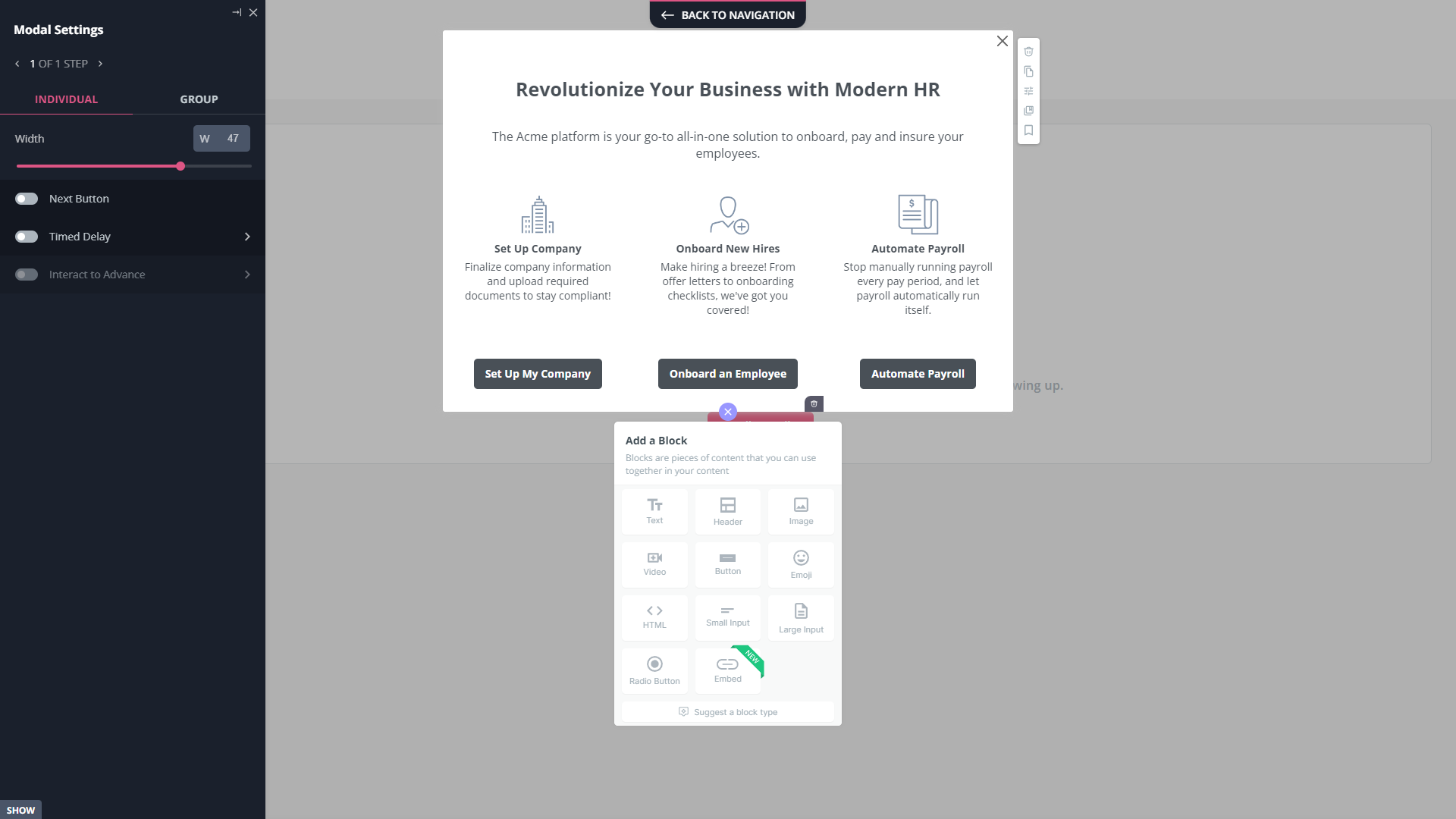
- Localization: Userpilot’s AI-powered localization engine comes pre-loaded with 32 languages that you can use to automatically translate your modals. You also have the ability to add languages manually by uploading a CSV to expand the translation options for your modals.

Userpilot’s in-app resource center
In-app resource centers help users find answers to their questions without needing to leave your product. Userpilot’s resource centers leverage advanced segmentation to target specific customers or use cases, have detailed analytics, and can be built using the no-code editor.
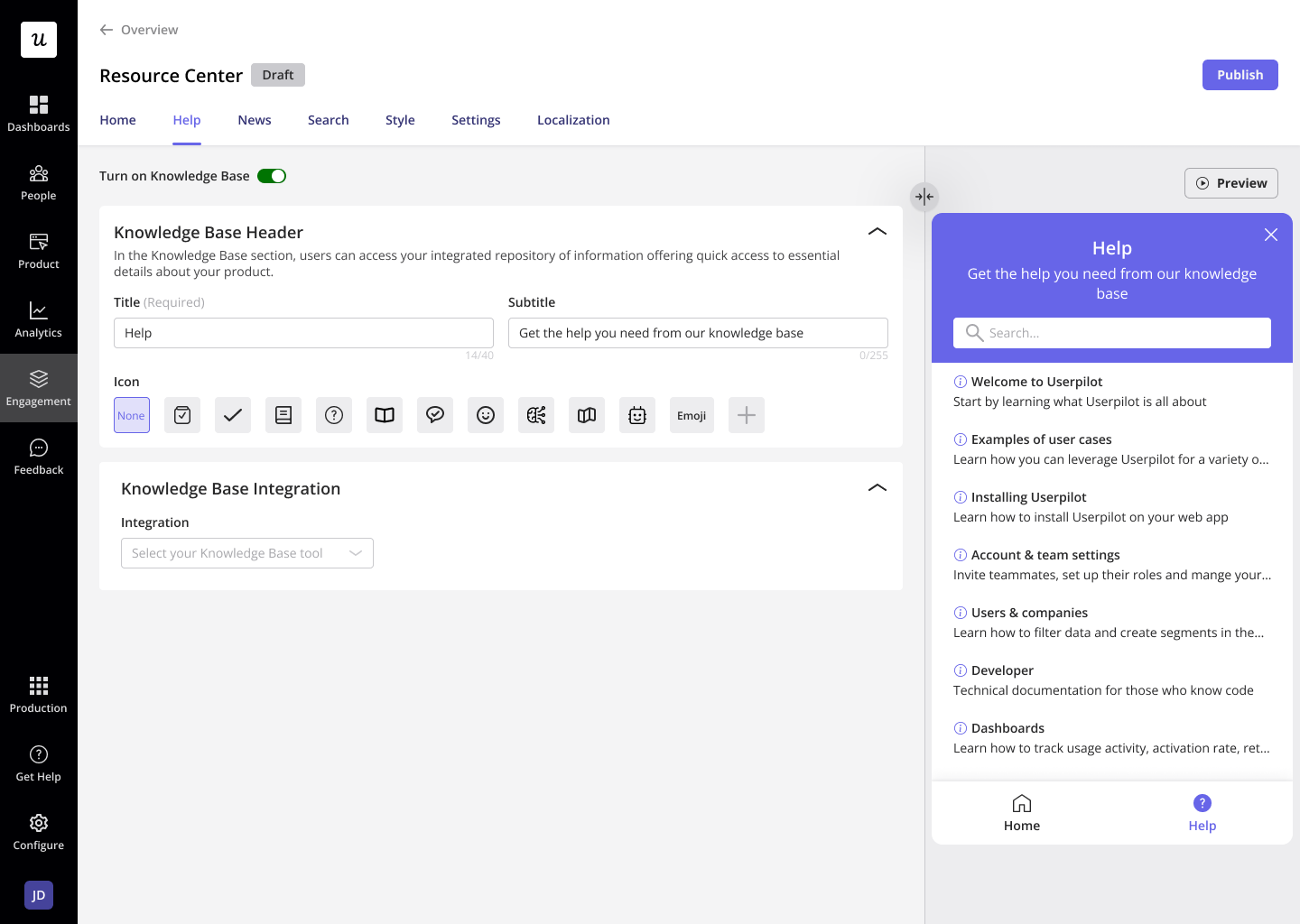
Here’s a closer look at Userpilot’s resource center editor:
- No-code editor: Userpilot lets you build in-app resource centers without needing to write any code. You can add modules like internal/external links, tutorial videos, in-app flows, custom JavaScript functions, and checklists — or group multiple modules into a single section.
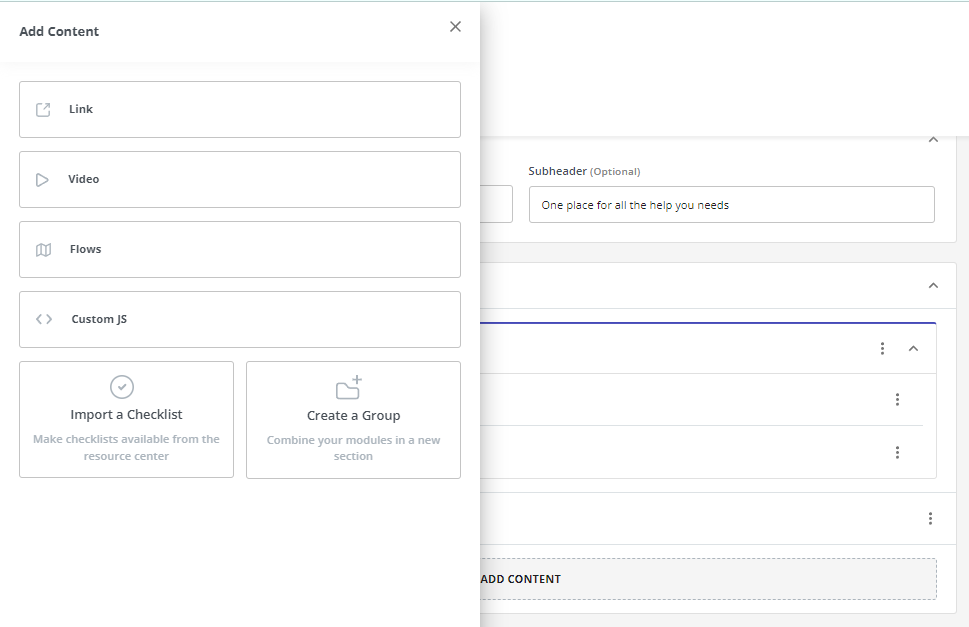
- Targeted modules: Userpilot’s module segmentation features let you show/hide specific resources depending on which segment a user is in. This helps you personalize your in-app resource center and only show the resources that are most relevant to a particular user.
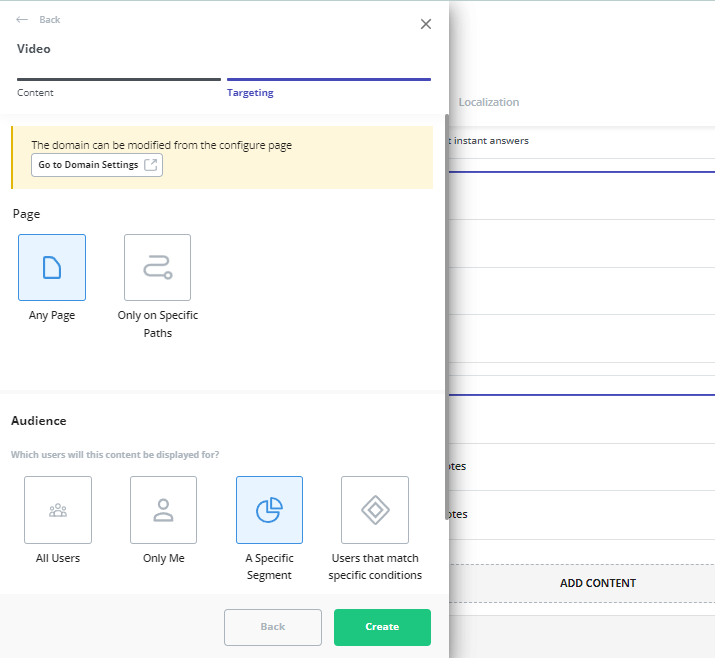
- Analytics dashboard: Userpilot’s resource center analytics can show you key metrics like the total number of visitors, how many modules have been clicked, and changes in the click rate to help you gauge performance. You can also sort data by a specific time period if needed.

Userpilot’s interactive walkthroughs
Interactive walkthroughs are better than linear product tours because they let new users learn by doing instead of dumping a ton of information on them all at once. Userpilot’s no-code features let you build advanced interactive walkthroughs and create personalized flows for each segment.
Here are the Userpilot features you can use to create interactive walkthroughs:
- No-code builder: Installing the Userpilot Chrome extension makes it possible to build interactive walkthroughs with zero coding needed. You’ll be able to use every UI pattern — such as modals, slideouts, tooltips, and driven actions — regardless of which plan you’re on.

- Welcome surveys: Userpilot lets you create welcome screens that survey users on what their primary use cases, roles, needs, etc., are. You can create different walkthroughs depending on their responses to ensure that there’s a personalized experience for all.
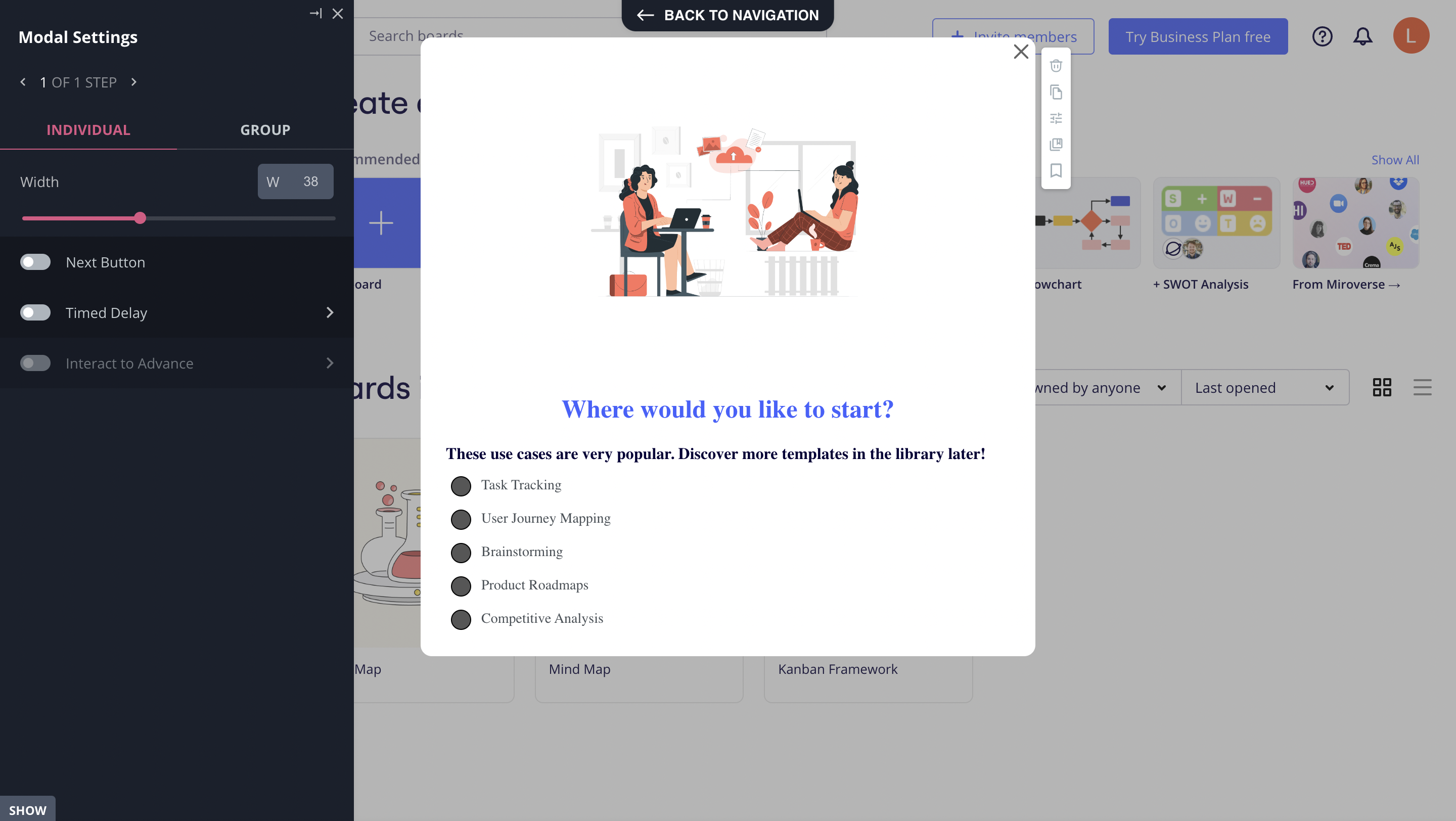
Example of a welcome survey built with Userpilot, not an actual welcome survey from Miro.
- Audience settings: The audience settings on Userpilot flows help you trigger or hide walkthroughs from specific users and segments. This makes it possible to create interactive walkthroughs that target a particular segment or trigger a flow when certain conditions are met.

What are the pros and cons of Userpilot?
Userpilot pros
As a full-suite digital adoption platform, Userpilot has all the features you need to onboard users, track analytics, and gather feedback from customers without writing a single line of code. Here are a few pros of using Userpilot as your product growth solution:
- No-code builder: Userpilot’s Chrome extension lets you build flows, add UI elements, and tag features without writing a single line of code.
- UI patterns: There are plenty of UI patterns to choose from when using Userpilot, such as hotspots, tooltips, banners, slideouts, modals, and more!
- Startup-friendly: Userpilot’s entry-level plan gives you access to all available UI patterns so you can hit the ground running.
- Walkthroughs and flows: Build engaging interactive walkthroughs and personalized onboarding flows that target specific segments of your user base.
- Self-service support: Build an in-app resource center to help users solve problems, customize its appearance to align it with your brand, and insert various types of content (videos, flows, or chatbots) to keep your customers satisfied.
- A/B testing: Userpilot’s built-in A/B testing capabilities will help you split-test flows, iterate on the best-performing variants, and continually optimize based on user behavior.
- Feedback collection: Userpilot has built-in NPS surveys with its own unified analytics dashboard and response tagging to help you retarget users. There are other survey types to choose from and you can even create your own custom survey.
- Survey templates: There are 14 survey templates to choose from so you can gather feedback on specific features or run customer satisfaction benchmarking surveys like CSAT and CES.
- Advanced analytics: Userpilot lets you analyze product usage data, monitor engagement on all in-app flows, and use the data to create user segments that are based on behaviors instead of demographics.
- Event tracking: Userpilot’s no-code event tracking lets you tag UI interactions (hovers, clicks, or form fills) and group them into a custom event that reflects feature usage.
- Third-party integrations: Userpilot has built-in integrations with tools like Amplitude, Mixpanel, Kissmetrics, Segment, Heap, HubSpot, Intercom, Google Analytics, and Google Tag Manager so you can share data between all the solutions in your tech stack.
Userpilot’s cons
Of course, no tool is perfect and there are a few cons to consider before choosing Userpilot as your user onboarding or product growth solution:
- Employee onboarding: Currently, Userpilot only supports in-app customer onboarding.
- Mobile apps: Userpilot doesn’t have any mobile compatibility which could make it difficult for developers with cross-platform applications to create a consistent user experience for both versions of their product.
- Freemium plan: There’s no freemium Userpilot plan so those bootstrapping their startup and need sub-$100 solutions should consider more affordable onboarding platforms like UserGuiding or Product Fruits.
What do users say about Userpilot?
Most users laud Userpilot for its versatile feature set, ease of use, and responsive support team:
I recently had the pleasure of using Userpilot, and I must say it exceeded all my expectations. As a product manager, I’m always on the lookout for tools that can enhance user onboarding and improve overall user experience. Userpilot not only delivered on these fronts but also went above and beyond with its impressive new features, unparalleled ease of use, and truly exceptional customer support.
What truly sets Userpilot apart is its outstanding customer support. Throughout my journey with Userpilot, the support team has been responsive, knowledgeable, and genuinely dedicated to helping me succeed. Whenever I had a question or encountered an issue, their support team was always there to assist promptly, going above and beyond to ensure my concerns were addressed effectively.

Source: G2.
Of course, other users are also kind enough to share constructive criticism regarding specific features like event tracking filters:
“The filtration while analyzing specific events is a little confusing. Understanding of custom properties and data management configuration could have been more organised.”

Source: G2.
Userpilot’s pricing
Userpilot’s transparent pricing ranges from $249/month on the entry-level end to an Enterprise tier for larger companies.
Furthermore, Userpilot’s entry-level plan includes access to all UI patterns and should include everything that most mid-market SaaS businesses need to get started.

Userpilot has three paid plans to choose from:
- Starter: The entry-level Starter plan starts at $249/month and includes features like segmentation, product analytics, reporting, user engagement, user feedback, and customization.
- Growth: The Growth plan starts at $499/month and includes features like resource centers, advanced event-based triggers, unlimited feature tagging, AI-powered content localization, EU hosting options, and a dedicated customer success manager.
- Enterprise: The Enterprise plan uses custom pricing and includes all the features from Starter + Growth plus custom roles/permissions, access to premium integrations, priority support, custom contract, SLA, SAML SSO, activity logs, security audit and compliance (SOC 2/GDPR).
Conclusion
There you have it.
It should be easier now to make an informed decision whether Lou Assist is your go-to option for proactive customer service. Ultimately, the best choice will depend on your product and current needs.
If you’re looking for a better alternative to Lou Assist for proactive customer service, book a Userpilot demo today to experience firsthand how it can enhance your user experience and drive product growth!
![]()
Looking for a Better Alternative for Proactive Customer Service? Try Userpilot


